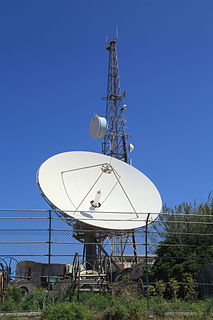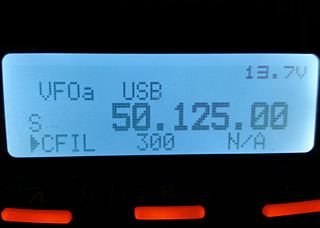Related Research Articles

This article is an overview of telecommunications in Malta.

Shortwave radio is radio transmission using shortwave radio frequencies. There is no official definition of the band, but the range always includes all of the high frequency band (HF), and generally extends from 3–30 MHz ; above the medium frequency band (MF), to the end of the HF band.
The American Radio Relay League (ARRL) is the largest membership association of amateur radio enthusiasts in the USA. ARRL is a non-profit organization, and was co-founded on April 6, 1914, by Hiram Percy Maxim and Clarence D. Tuska of Hartford, Connecticut. The ARRL represents the interests of amateur radio operators before federal regulatory bodies, provides technical advice and assistance to amateur radio enthusiasts, supports a number of educational programs and sponsors emergency communications service throughout the country. The ARRL has approximately 161,000 members. In addition to members in the US, the organization claims over 7,000 members in other countries. The ARRL publishes many books and a monthly membership journal called QST. The ARRL held its Centennial Convention in Hartford, Connecticut in July 2014.

Sweat Mountain is a low mountain in far northeastern Cobb County, Georgia, in the suburbs north of Atlanta. The exact GNIS location of its summit is 34°4′1″N84°27′20″W, and it has an official (USGS) elevation of 1,688 ft (515 m) above mean sea level. It is the second-highest point in the county behind Kennesaw Mountain, and second in the core metro Atlanta area, behind Kennesaw Mountain, which is also in Cobb County. It is fifth if the exurban counties further north are considered.

The 1.25 meter, 220 MHz or 222 MHz band is a portion of the VHF radio spectrum internationally allocated for amateur radio use on a primary basis in ITU Region 2, and it comprises frequencies from 220 MHz to 225 MHz. In the United States and Canada, the band is available on a primary basis from 222 to 225 MHz, with the addition of 219 to 220 MHz on a limited, secondary basis. It is not available for use in ITU Region 1 or ITU Region 3. The license privileges of amateur radio operators include the use of frequencies within this band, which is primarily used for local communications.
Earth–Moon–Earth communication (EME), also known as Moon bounce, is a radio communications technique that relies on the propagation of radio waves from an Earth-based transmitter directed via reflection from the surface of the Moon back to an Earth-based receiver.

The 6-meter band is the lowest portion of the very high frequency (VHF) radio spectrum allocated to amateur radio use. The term refers to the average signal wavelength of 6 meters.
LowFER refers to experimental radio communication practiced by hobbyists on frequencies below 300 kHz, a part of the radio spectrum known as low frequency. The practitioners are known as "LowFERs".
The 20-meter or 14-MHz amateur radio band is a portion of the shortwave radio spectrum, comprising frequencies stretching from 14.000 MHz to 14.350 MHz. The 20-meter band is widely considered among the best for long-distance communication (DXing), and is one of the most popular—and crowded—during contests. Several factors contribute to this, including the band's large size, the relatively small size of antennas tuned to it and its good potential for daytime DX operation even in unfavorable propagation conditions.
The 10-meter band is a portion of the shortwave radio spectrum internationally allocated to amateur radio and amateur satellite use on a primary basis. The band consists of frequencies stretching from 28.000 to 29.700 MHz.

The 60-meter band or 5 MHz band is a relatively new amateur radio allocation, first introduced in 2002, that was originally only available in a few countries, such as the United States, United Kingdom, Norway, Finland, Denmark, Ireland and Iceland. Over a number of years however, an increasing proportion of countries' telecommunications administrations – together with their government and military users – have permitted Amateur Radio operation in the 5 MHz area on a short or longer term basis, ranging from discrete channels to a frequency band allocation.
Amateur radio frequency allocation is done by national telecommunication authorities. Globally, the International Telecommunication Union (ITU) oversees how much radio spectrum is set aside for amateur radio transmissions. Individual amateur stations are free to use any frequency within authorized frequency ranges; authorized bands may vary by the class of the station license.

In times of crisis and natural disasters, amateur radio is often used as a means of emergency communication when wireline, cell phones and other conventional means of communications fail.

An amateur radio repeater is an electronic device that receives a weak or low-level amateur radio signal and retransmits it at a higher level or higher power, so that the signal can cover longer distances without degradation. Many repeaters are located on hilltops or on tall buildings as the higher location increases their coverage area, sometimes referred to as the radio horizon, or "footprint". Amateur radio repeaters are similar in concept to those used by public safety entities, businesses, government, military, and more. Amateur radio repeaters may even use commercially packaged repeater systems that have been adjusted to operate within amateur radio frequency bands, but more often amateur repeaters are assembled from receivers, transmitters, controllers, power supplies, antennas, and other components, from various sources.

The Trinidad and Tobago Amateur Radio Society, Inc. (TTARS) is the national amateur radio organization in the Republic of Trinidad and Tobago. It is a member society of the International Amateur Radio Union (IARU).
An amateur radio propagation beacon is a radio beacon, whose purpose is the investigation of the propagation of radio signals. Most radio propagation beacons use amateur radio frequencies. They can be found on LF, MF, HF, VHF, UHF, and microwave frequencies. Microwave beacons are also used as signal sources to test and calibrate antennas and receivers.

Amateur radio, also known as ham radio, is the use of radio frequency spectrum for purposes of non-commercial exchange of messages, wireless experimentation, self-training, private recreation, radiosport, contesting, and emergency communication. The term "amateur" is used to specify "a duly authorised person interested in radioelectric practice with a purely personal aim and without pecuniary interest;" and to differentiate it from commercial broadcasting, public safety, or professional two-way radio services.

Although there is anecdotal evidence of an amateur radio club in Omaha prior to World War II, The Ak-Sar-Ben Amateur Radio Club (AARC), as it exists today, was started in 1945 and has been affiliated with the American Radio Relay League (ARRL) since that time. The club is not affiliated with The Knights of Ak-Sar-Ben.

The Waverley Amateur Radio Society (WARS) is an amateur radio society based in Rose Bay, a suburb of Sydney, New South Wales, Australia which operates under the call sign VK2BV. The society was founded in 1919 and is the oldest continuously licensed amateur radio club in Australia.
References
- ↑ "Camden Daily Courier". Camden Daily Courier. 1916-06-13.
eighteen amateurs met at the home of W. G. Phillips located at 140 Washington Avenue, Collingswood, New Jersey on 12 June 1916.
- ↑ "The ARRL Letter March 8, 1996 (Volume 15, Number 3)". American Radio Relay League . Retrieved 2007-01-18.
- ↑ "The History Of The Milwaukee Radio Amateurs' Club Inc, 2006 Edition" (PDF). Milwaukee Radio Amateurs’ Club . Retrieved 2007-01-18.[ dead link ]
- ↑ Radio Communication: Hearings before the Committee on the Merchant Marine and Fisheries - House of Representatives - Sixty-Fourth Congress - Second Session on H.R. 19350 - A Bill to Regulate Radio Communication - Part 1 - January 11, 12, And 13, 1917 Page=221. Washington Government Printing Office. 1917.
- ↑ "Club Detail Record: South Jersey Radio Assn". American Radio Relay League.